Quaker Hills
Introduction
After six field seasons the Pennsylvania Historical and Museum Commission's (PHMC) Section of Archaeology terminated excavations at the Quaker Hills Quarry (36LA1100) Site, a four acre size Shenks Ferry village site located in Lancaster County, Pennsylvania. The property is transitioning from a corn and bean field to a high density residential development replete with efficient condominium size homes, lawns and paved drives. In compliance with the Pennsylvania State History Code the PHMC undertook a multi-season archaeological study at 36LA1100. The work involved a detailed surface evaluation of prehistoric resources and broad scale data recovery within the proposed development. The endeavor provides a glimpse of prehistoric Indian life at the dawn of history and we would like to share that information with the citizens of Pennsylvania and others having an interest in the Commonwealth's archaeological heritage.
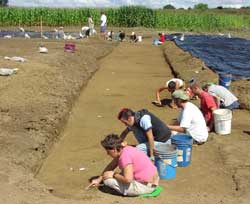
Shenks Ferry Background
Prior to PHMC's investigations at 36LA1100, only five Lancaster County Shenks Ferry villages illuminate the nature, design and internal composition of mid to late phase Shenks Ferry settlements dated circa 1425-1550 A.D. These include Mohr (36LA39), near Bainbridge; two juxtaposed villages at the Schultz (36LA7)/Schultz-Funk (36LA9), at Washington Boro; Murry 36LA183), also near Washington Boro; Shenks Ferry (36LA2) type site for the Shenks Ferry Culture situated near Safe Harbor; and Slackwater (36La207), near the town of Millersville and a short distance from the Quaker Hills Quarry Site.
In terms of the occupational sequence based on notable differences in ceramic typology and radiocarbon dating, the Lancaster Phase Mohr Site occupation appears earliest followed, provisionally, by Murry, Slackwater, Quaker Hills Quarry, Schultz/Schultz-Funk and Shenks Ferry. These other sites are ascribed to the Funk Phase, perhaps better understood as the surviving or terminal stage entity of Shenks Ferry culture up until the arrival of the non-indigenous Susquehannocks from northern Pennsylvania.
With the assistance of Temple University staff and students, PHMC exposed, mapped and selectively excavated more than 50% of the Funk Phase Shenks Ferry village component at the Quaker Hills Quarry Site. The results provided sufficient information to determine site size, arrangement of living structures and related pit features, and other salient information on subsistence and mortuary practices.
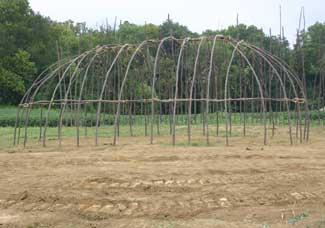
Settlement Composition Reconstructed framework of a Shenks Ferry house structure and palisade wall at 36LA1100.
At the outer-most edge of the village the discovery of numerous postmolds arranged along a broad continuous arch proved to be the palisade wall that perhaps once reached a height of 4.5 meters or more based on measurements of several post hole stains. Computation estimates based on the archaeological evidence demonstrate that this defensive feature was 150 meters in diameter, a rather large village by an standard.
The first arc of postmolds forming circular to rectangular-shaped patterns measured seven to nine meters in size were discovered approximately eight meters inside the palisade line. An adequate surface area within the village was opened to show that they followed the approximate arc of the palisade and that they were the remains of house patterns consistently spaced along the arc.
Postmold remnants forming a second arc of similarly shaped house patterns were also found another eighteen meters inward from the first line of house prints. As well, these followed the general arc of the village though their overall dimensions were greater, ranging from eight to eleven meters in size. Non-patterned clusters of other postmolds were identified between the two house arcs. Their presence there suggests that other buildings may have also existed during the Shenks Ferry occupation of the site.
Excavations continued to the center of the site where an oval-shaped postmold pattern twelve meters long by 7.5 meters wide was discovered. The postmolds formed the remains of a structure at a distance of twenty four meters beyond the second arc of houses and positioned with its orientation east-west. We believe that a second larger structure, was also built at or near the center of the site. It, however, was circular-shaped, measuring 15 meters in diameter and located directly north of the smaller oval-shaped structure.
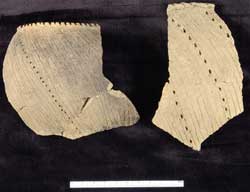
Pit Features and other Subsurface Anomalies
Interspersed within and around the palisade and houses at the Quaker Hills Quarry Site were subsurface disturbances that showed up as dark colored stains in the surrounding sterile subsoil. Many of these often irregularly shaped stains proved to be nothing more than animal burrowing and tree root canals that formed during or after, the Shenks Ferry Indians occupied the site. As well, the archaeologists found three distinct lines of square shaped post holes that cut through the village and about a dozen shallow trench-like features that we believe belong to 19th century fence rows and cold frame structures used for the germination of tobacco seed, respectively.
Prehistoric features included cooking hearths, trash pits, graves, a keyhole structure and natural debris filled depressions. These features, especially the filled depressions and animal burrows contained evidence of midden. Most likely such material was tossed from Shenks Ferry dwellings during periodic cleanings and ended up in these features on the site.
Each house had a raised central hearth with an encircling donut shaped depression used for cooking and comfort during colder periods of the year. One or more oval-shaped pits for ash and organic trash discard, commonly accompanied the houses. Usually these features were placed outside or near the palisade. Carbonized cultigens including corn, beans, rind fragments of squash, seed fragments, tiny fish and rodent bones were identified through careful water flotation of the entire contents of all excavated feature.
In typical Shenks Ferry fashion, human interments were placed in a laid out position with the head oriented eastward. Adult males and females were interred near the palisade wall while those of younger ages placed beneath house floors houses, usually located closer to the center of the village. Unique to this Shenks Ferry settlement was the discovery of a semi-subterranean post-lined pit commonly referred to in archaeological parlance as a keyhole structure. These distinctive features with their eastward openings and grass thatched covering are common on northern Pennsylvania Late Woodland sites but until the discovery at 36LA1100 during the summer of 2006 this type of feature was unknown for Funk Phase Shenks Ferry settlements of the lower Susquehanna Valley. Archaeologists speculate that keyhole structures were used in ritual sweating, smoke curing of certain foods and/or semi-subterranean storage sheds for perishable foods.
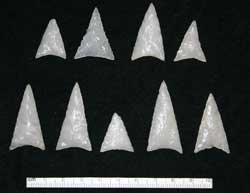
Sample of quartz triangular projectile points from the PHMC excavations at 36LA1100.
Artifact Assemblage
The principal artifacts include objects made from stone, clay, bone and shell. That there were other objects of Shenks Ferry Indian manufacture at 36LA1100 is assumed but due to the untenable nature of preservation involving the changing seasons and wet soil conditions, none of those items seem to have survived.
Triangular-shaped points made from high grade quartz, and to a lesser degree, chalcedony, chert and jasper obtained from southeastern Pennsylvania were the common lithics used to tip arrows at 36LA1100. Most of the points have a slight concavity to the base while the lateral edges are straight to slightly excurvate. Others from the excavation take on a true isosceles form.
Cordmarked incised pottery recovered from every section of the village site investigated by PHMC was entirely of the Funk Incised type. Characteristics distinguishing this pottery from all other Shenks Ferry types is the notched lip treatment and often highly pronounced rim/collar that takes on a tulip or bulbous shaped appearance. While collar designs on these vessels can be highly complex having infilled panels of opposing triangles and bordering punctuates made with reed or hollow bone styli, most are decorated with a series of simple parallel incisions forming parallelograms, triangles or trapezoid designs. Other pots were simply decorated with markings made by impressing or stamping a cordwrapped paddle tool over their outer surface.
All of the tooth, bone and antler objects from the site were made from the skeletal parts of birds, mammals and reptiles. With the exception of a single antler arrow tip, several awls and a bone fleshing tool these objects were designed for use as decorative body adornment. As well, shell items fashioned into beads included the twisted cores and shell plates from large marine conchs to tiny marginella shells, collected from points as far away as the coast of North Carolina. These objects doubtless made their way into the lower Susquehanna valley and further afield through exchange between contemporary groups operating in the Middle Atlantic area.
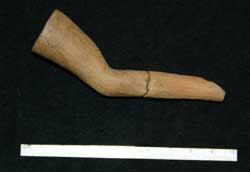
How Old is the Village?
Archaeologists place the Shenks Ferry Culture into the Late Woodland Period (circa 1250-1550 A.D.) This three hundred year range of time is principally determined by radiocarbon dating charcoal and organic residues found in association with certain Shenks Ferry artifact types of the Susquehanna Valley. The age of Funk Phase sites (the latest phase of Shenks Ferry) tends to cluster around the mid to late 15th century with a few sites surviving well into the beginning of the 16th century.
The largely agreeable number of radiocarbon dates for the Quaker Hills Quarry Site indicates an occupation period closer to the first quarter of the 16th century during a time when the New World was undergoing many changes. Archaeologists have stated that the correlation between the disappearance of Shenks Ferry and the arrival of the Susquehannocks may not have come about on amenable terms and that some Shenks Ferry settlements may actually have been overrun by invading Susquehannocks. This conquest theory has met with some challenge, however, and other reasons may have precipitated their demise.
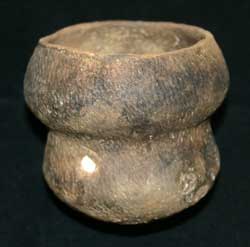
Locust Grove Cordmarked pottery vessel from the PHMC excavations at 36LA1100.
Feast to Famine?
Most unusual regarding the subsistence evidence was the scarcity of large mammal remains recovered from the trash pits at the Quaker Hills Quarry Site. In comparing the faunal evidence from the other five Shenks Ferry site studies we find a discontinuity in the representation of certain animal species at 36LA1100. These differences are, in the same sense, also mirrored by the magnitude of faunal diversity at other contemporaneous village sites in the Northeast and Middle Atlantic regions. The bones and other food refuse that we recovered from the site's trash pits and other subsurface features show a significant under representation in the number of large mammals. In contrast, other Late Woodland sites, where deer, elk and bear show up as the most commonly represented mammals harvested during the hunt, these animals, though present, seem to be rare at the Quaker Hills Quarry Site. In contrast, the faunal record shows a higher than normal frequency of small river related species which include minnows, naiads and other aquatic creatures.
We hypothesize that the evidence may suggest that during the late15th to the early 16th century, local Shenks Ferry populations experienced some level of environmental or social stress that brought on inter-cultural strain between villages situated close together through the over exploitation of limited food resources. Add to this, the potential risks that might have existed among prehistoric populations experiencing climatic deterioration, and territorial strife, it is easy for one to imagine the deleterious effects these factors would have on the human condition. We are presently evaluating this hypothesis to possibly determine the fate of the Shenks Ferry people of the Quaker Hills Quarry Site.